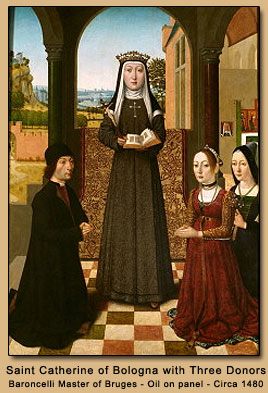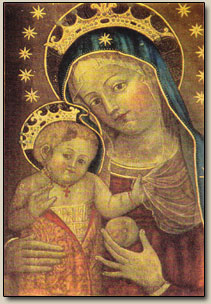|
 A
fifteenth-century cloistered nun who lived and died in relative
obscurity doesn’t seem the most obvious choice to be Patron Saint of
Artists. Yet a closer look at the life of St. Catherine of Bologna shows
that she is indeed a saint worthy to intercede for and inspire artists.
Her creative spirit, talents, visions, and struggle with doubts make her
a saint even modern-day artists can relate to. A
fifteenth-century cloistered nun who lived and died in relative
obscurity doesn’t seem the most obvious choice to be Patron Saint of
Artists. Yet a closer look at the life of St. Catherine of Bologna shows
that she is indeed a saint worthy to intercede for and inspire artists.
Her creative spirit, talents, visions, and struggle with doubts make her
a saint even modern-day artists can relate to.
Saint Catherine of Bologna (8 September 1413 – 9 March 1463) was an Italian nun, artist and saint.
Catherine de' Vigri was venerated for nearly three centuries in her native Bologna before being formally canonized, in 1712. Her feast day is 9 March.
Catherine came from an aristocratic Bolognese
family, From the age of nine, she was raised at the court of the Duke of
Ferrara. During this time, she received an excellent training in
reading, writing, music, singing, drawing and illuminating.
In 1426, however, after twelve years at court, she left and entered the convent of Corpus Domini at Ferrara.
In spite of her aristocratic background and education, Catherine willingly served in the more humble roles at the convent, including laundress, baker, and caretaker to the animals. Late in her life, she obediently left her beloved Ferrara monastery to form a new convent i n Bologna, where she served as abbess despite her desire for a less prominent role.
In 1432 together with other young women of Ferrara, she founded a monastery of
the Order of Poor Clares. n Bologna, where she served as abbess despite her desire for a less prominent role.
In 1432 together with other young women of Ferrara, she founded a monastery of
the Order of Poor Clares.
Woman painters were rare in the Middle Ages, yet, Catherine
praised God through her art. She painted pictures of Jesus, Mary,
and the saints. She created beautiful illuminated manuscripts by
painting small illustrations on the pages of prayer books and
Bibles, which she also lettered and copied by hand. She also wrote
books and poems about her faith.
She continued in her artistic pursuits, playing the viola (even on her deathbed), painting religious pictures (her painting of St. Ursula hangs today in a gallery in Venice), copying out and illuminating her breviary (once belonging to Pius IX and now on display at Oxford), and writing spiritual guides and poetry.
Several
of her larger paintings are treasured in Spanish and Italian Galleries,
among them the Galerie dell’Academia.
|